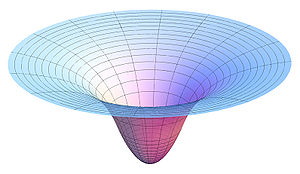Yet you go on to contradict what you seemingly here approve of!Good stuff Schmelzer.
Ignoring a few fine points there, above need have nothing or only indirectly anything to do with relative time dilation at a given location. The definition of time dilation is equivalent, as explained in earlier posts, to the redshift. Either 'absolute' - as referring to observer at infinite distance, or relative, as between two different elevations. In either case, a function of the Newtonian gravitational potential, with no gradients involved whatsoever. As given e.g. in #9:You are plotting the speed of light, which you typically refer to as gravitational potential. The force of gravity at some location depends on the gradient in the speed of light, which relates to the slope of the plot at that location. The curvature you can see in your plot relates to the tidal force, and to the Riemann curvature tensor. This is the "defining feature" of a gravitational field because without this curvature, your plot is flat and level, the speed of light is constant, and therefore light doesn't curve and your pencil doesn't fall down.
https://en.wikipedia.org/wiki/Gravi...rtant_features_of_gravitational_time_dilation
Wrong. His statement you were there quoting was correct. The radial spatial gradient in the spatial component of metric field gives you approx minus twice the 'g' field. You have some personal interpretation of what a metric field is.It isn't. The difference in the metric field at different spacetime points gives you the gravitational gradient.
Which therefore becomes your problem since what you quoted there was wrong. Flat spacetime is not always synonymous with zero redshift i.e. time dilation. Interior of hollow shell as chief example - already covered in earlier posts, but here's another article (See first comment by Richard Muller below main article):No problem with that.
https://www.quora.com/Why-is-gravity-inside-a-spherical-shell-considered-to-be-zero
Your last mixed quote, with you claiming time dilation and 'spatial energy density' are linked is just nonsense. In flat vacuum region, as in hollow interior of a matter shell, there is no 'energy density' owing to any influence of the surrounding shell. Just a depressed potential and in GR (standard Schwarzschild metric) just a depressed temporal metric component, with spatial metric completely undepressed. The latter a strange consequence of transverse spatial metric having no dependence on potential anywhere. But pursuing that can of worms is another topic.

